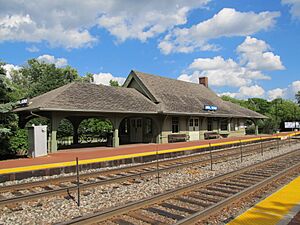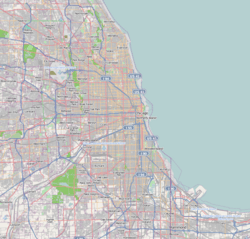Golf, Illinois facts for kids
Quick facts for kids
Golf, Illinois
|
||
|---|---|---|

Golf station
|
||
|
||

Location in Cook County and the state of Illinois
|
||
| Country | United States | |
| State | Illinois | |
| County | Cook County | |
| Settled | 1830s | |
| Incorporated | 1928 | |
| Area | ||
| • Total | 0.45 sq mi (1.16 km2) | |
| • Land | 0.45 sq mi (1.16 km2) | |
| • Water | 0.00 sq mi (0.00 km2) | |
| Population
(2020)
|
||
| • Total | 514 | |
| • Density | 1,147.32/sq mi (442.60/km2) | |
| Time zone | UTC-6 (CST) | |
| • Summer (DST) | UTC-5 (CDT) | |
| ZIP Code(s) |
60029
|
|
| FIPS code | 17-30328 | |
Golf is a small village in Cook County, Illinois, United States. It was officially started in 1928. In 2020, about 514 people lived here. Golf is mostly a place where people live, and it has its own police department, post office, and a Metra train stop that connects it to bigger cities.
Contents
History of Golf Village
The village of Golf is located in Cook County, Illinois. It is about 17 miles (27 km) northwest of downtown Chicago.
Early Inhabitants and Settlers
Long ago, the land where Golf now stands was home to the Chippewa, Ottawa, and Potawatomi Native American tribes. In 1825, a treaty set aside this land for their settlement.
Around 1830, a man named John Dewes bought 400 acres (160 hectares) of land. He paid 50 cents an acre! He was the first non-Native American settler in the area. John Dewes first built a simple log cabin. Later, in 1834, he built a large brick house. Both of these buildings are still part of the Glen View Club today.
The Glen View Club and the "Golf Stop"
In 1897, the Glen View Club bought some of John Dewes's land. They built a big 18-hole golf course there.
Around 1899, a club member named Albert J. Earling, who was the president of a railroad company, started taking his private train car from Chicago to play golf. When people asked where he was going, he would say he was "going to golf."
Mr. Earling arranged for his train car to be switched onto a special side track, called a siding. This siding was right where the Golf train station is now. Other club members started using this special stop too. Soon, it became a regular train stop known as the "golf stop." This siding was later removed during World War II to use the steel for the war effort.
How Golf Became a Village
In 1925, a Chicago businessman named Edward R. Diederich wanted to buy land near the Glen View Golf Club. To get the spot he wanted, he had to buy a 30-acre (12-hectare) piece of land.
This land stretched from the train station to the golf club. Diederich bought the land and designed it with curvy streets and large lots for homes. He added important services like sewers, water, gas, electricity, paved streets, sidewalks, and street lights. The village of Golf was officially started in 1928. The Glen View Club became part of the village around 1975.
Geography of Golf
Golf is a small village. According to the 2010 census, it covers about 0.45 square miles (1.16 square kilometers) of land. There is no water area within the village limits.
Who Lives in Golf?
In 2020, the village of Golf had 514 people living there. There were 167 households, which means 167 groups of people living in homes. Most of these were families.
Population Changes Over Time
The number of people living in Golf has changed over the years:
- 1930: 112 people
- 1940: 158 people
- 1950: 258 people
- 1960: 409 people
- 1970: 504 people
- 1980: 482 people
- 1990: 454 people
- 2000: 451 people
- 2010: 500 people
- 2020: 514 people
Age and Income
In 2020, about 27.4% of the people in Golf were under 18 years old. About 18.2% were 65 years or older. The average age was about 46.8 years old.
The average income for a household in Golf was quite high, around $201,875 in 2020. This shows that Golf is a well-off community.
Education in Golf
Golf School was built in 1927. It was a simple country schoolhouse with four rooms, no electricity, and no running water. Later, a larger brick building was added.
Changes in School Districts
For many years, students from Golf went to Golf Elementary School and Golf Junior High School. Then they went to Niles North High School.
In the early 1980s, Golf residents decided to join different school districts. They wanted to be part of the school districts in Glenview, which were known for being very good. After some discussions, Golf officially changed its school districts in the 1980s.
Current Schools for Golf Students
Today, public school students from Golf attend:
- Lyon School
- Pleasant Ridge School
- Springman Middle School (all part of Glenview School District 34)
- Glenbrook South High School (part of District 225)
Getting Around Golf
Golf is well-connected to the transportation system of Chicago and the surrounding areas.
Roads for Driving
Several important roads pass near Golf:
 Edens Expressway
Edens Expressway Tri-State Tollway
Tri-State Tollway Waukegan Road
Waukegan Road Golf Road
Golf Road
Public Transportation
You can use public transport in Golf:
- Trains: The Milwaukee District North Line of Metra has a stop in Golf.
- Buses: Pace suburban bus routes 208 and 210 serve the area.
Nearby Airports
For air travel, there are several airports not too far from Golf:
- O'Hare International Airport
- Midway Airport
- Chicago Executive Airport
See also
 In Spanish: Golf (Illinois) para niños
In Spanish: Golf (Illinois) para niños




